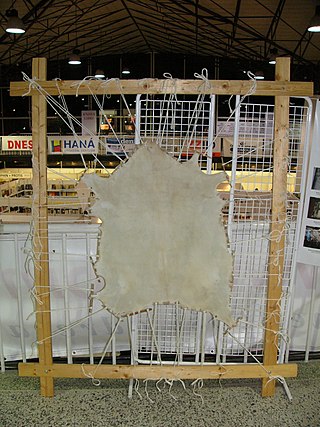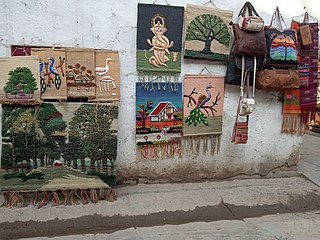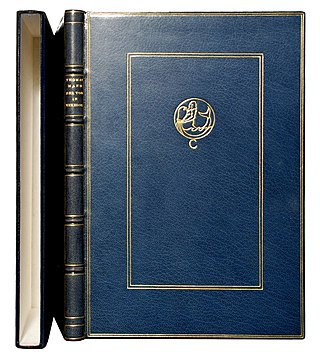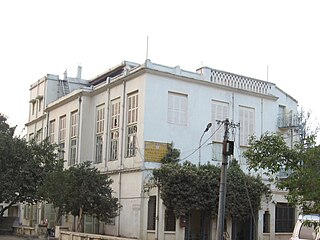
Leather is a strong, flexible and durable material obtained from the tanning, or chemical treatment, of animal skins and hides to prevent decay. The most common leathers come from cattle, sheep, goats, equine animals, buffalo, pigs and hogs, and aquatic animals such as seals and alligators.

A handicraft, sometimes more precisely expressed as artisanal handicraft or handmade, is any of a wide variety of types of work where useful and decorative objects are made completely by one's hand or by using only simple, non-automated related tools like scissors, carving implements, or hooks. It is a traditional main sector of craft making and applies to a wide range of creative and design activities that are related to making things with one's hands and skill, including work with textiles, moldable and rigid materials, paper, plant fibers, clay, etc. One of the oldest handicraft is Dhokra; this is a sort of metal casting that has been used in India for over 4,000 years and is still used. In Iranian Baluchistan, women still make red ware hand-made pottery with dotted ornaments, much similar to the 5,000-year-old pottery tradition of Kalpurgan, an archaeological site near the village. Usually, the term is applied to traditional techniques of creating items that are both practical and aesthetic. Handicraft industries are those that produce things with hands to meet the needs of the people in their locality without using machines.

Jute is a long, rough, shiny bast fibre that can be spun into coarse, strong threads. It is produced from flowering plants in the genus Corchorus, of the mallow family Malvaceae. The primary source of the fiber is Corchorus olitorius, but such fiber is considered inferior to that derived from Corchorus capsularis.
A hide or skin is an animal skin treated for human use. The word "hide" is related to the German word Haut, which means skin. The industry defines hides as "skins" of large animals e.g. cow, buffalo; while skins refer to "skins" of smaller animals: goat, sheep, deer, pig, fish, alligator, snake, etc. Common commercial hides include leather from cattle and other livestock animals, buckskin, alligator skin and snake skin. All are used for shoes, clothes, leather bags, belts, or other fashion accessories. Leather is also used in cars, upholstery, interior decorating, horse tack and harnesses. Skins are sometimes still gathered from hunting and processed at a domestic or artisanal level but most leather making is now industrialized and large-scale. Various tannins are used for this purpose. Hides are also used as processed chews for dogs or other pets.

Goatskin refers to the skin of a goat, which by long term usage, is denoted by the term Morocco leather. Kidskin, used for gloves, shoes and other accessories, is traditionally goatskin, although other leathers such as sheep and kangaroo can be used to make kid.

Nepalese handicraft history can be traced back to the Stone Age when human beings were inadequate of tools of every things. The history of artistic handicrafts only began during the 5th century AD, when different religions began to form their bases among the people of Nepal. Hence we see a lot of religious influence on Nepalese handicrafts.

Morocco leather is a vegetable-tanned leather known for its softness, pliability, and ability to take color. It has been widely used in the manufacture of gloves and the uppers of ladies' shoes and men's low cut shoes, but is commonly associated with wallets, linings for fine luggage, and bookbindings.

A club chair is a type of armchair, usually covered in leather. It was created and made in France. Before it came to be known under its current name, it first appeared as the fauteuil confortable, the 'comfortable armchair'. It was given this name to distinguish it from the fauteuil de style, which had straighter lines and was less enveloping.

Hidesign is a leather goods manufacturer based in Pondicherry, India. In 2018, the company had operations in 24 countries including the United States, United Kingdom, Australia, Kenya, United Arab Emirates, Spain, Portugal, New Zealand and Sri Lanka. The leather goods segment of Hidesign contributes to 160 crore of revenue.

Amar Kutir, once a place of refuge for independence movement activists has been turned into a cooperative society for the promotion of arts and crafts. It is located on the banks of the Kopai River, about 15 kilometres (9.3 mi) from Santiniketan in Birbhum district in the Indian state of West Bengal.
In Pakistan, cottage or household industries hold an important position in rural set-up. Most villages are self-sufficient in the basic necessities of life. They have their own carpenters, cobblers, potters, craftsmen and cotton weavers. Many families depend on cottage industries for income.

Kalamkari is a type of hand-painted cotton textile produced in the Indian state of Andhra Pradesh. Only natural dyes are used in Kalamkari, which involves twenty-three steps.
East India Leather is an Indian vegetable-tanned leather produced by the tanneries in Trichy and Dindigul in Tamil Nadu.

Kazakh clothing, worn by the Kazakh people, is often made of materials suited to the region's extreme climate and the people's nomadic lifestyle. It is commonly decorated with elaborate ornaments made from bird beaks, animal horns, hooves and feet. Although contemporary Kazakhs usually wear Western dress, the Turkic people wear more traditional clothing for holidays and special occasions.
Russia leather is a particular form of bark-tanned cow leather. It is distinguished from other types of leather by a processing step that takes place after tanning, where birch oil is worked into the rear face of the leather. This produces a leather that is hard-wearing, flexible and resistant to water. The oil impregnation also deters insect damage. This leather was a major export good from Russia in the 17th and 18th centuries because of its high quality, its usefulness for a range of purposes, and the difficulty of replicating its manufacture elsewhere. It was an important item of trade for the Muscovy Company. In German-speaking countries, this leather was also known by the name Juchten or Juften.

Bagh print is a traditional Indian handicraft originating in Bagh, Dhar district of Madhya Pradesh, India. The process is characterised by hand printed wood block relief prints with naturally sourced pigments and dyes. Bagh print motifs are typically geometric, paisley, or floral compositions design, dyed with vegetable colours of red and black over a white background, and is a popular textile printing product. Its name is derived from the village Bagh located on the banks of the Bagh River.
The splitting band knife is a kind of knife used in several fields including: tannery, EVA/rubber, foam, cork, shoe and leather goods, paper, carpet and other soft sheet materials. It is a power tool which is very similar in operation to a band saw, with an endless loop blade; the material to be cut is supported by a flat table.
Mangalagiri Sarees and Fabrics are produced by performing handicraft weaving in Mangalagiri, a town in Guntur district of the Indian state of Andhra Pradesh. It was registered as one of the handicraft in the geographical indication from Andhra Pradesh by Geographical Indications of Goods Act, 1999.

Madurkathi mats, or madur, are mats woven in West Bengal from a reed called madur kottir, or madurkathi, a sedge of the family Cyperaceae. Madur mat-making is a long-standing tradition, centred on the Medinipur district, and is an important part of the rural economy. The mats are woven mainly by weavers of the Mahishya caste, and predominantly by women. This cottage industry contributes significantly to village household income.

Palli Samgathana Vibhaga, of Visva-Bharati University, was established at Sriniketan in 1922, by the Nobel laureate Rabindranath Tagore. Leonard Knight Elmhirst was its first director.
















